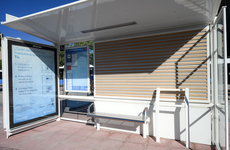
Detroit's Door Stops Bus Shelters Are Made From Abandoned House Materials
Alyson Wyers — April 28, 2014 — Eco
References: doorstopsdetroit.org & fastcoexist
These artistic bus shelters in Detroit have the upcycling concept covered. Door Stops creates new bus shelters by recycling doors from abandoned houses.
According to Craig Wilkins, who teaches at the University of Michigan's Taubman College of Architecture and Urban Planning and helped launch this project, Detroit's transit system is lacking. Door Stops helps make a potential 2 hour wait for the bus a little more pleasant.
As the city of Detroit is tearing down many abandoned homes, there is no shortage of rescuable parts for bus shelters. By reusing doors, Door Stops is making a statement about alternative uses for these buildings and materials. Even though an architectural salvage company takes some unique parts of demolished housing, commonplace items like doors end up in landfills.
According to Craig Wilkins, who teaches at the University of Michigan's Taubman College of Architecture and Urban Planning and helped launch this project, Detroit's transit system is lacking. Door Stops helps make a potential 2 hour wait for the bus a little more pleasant.
As the city of Detroit is tearing down many abandoned homes, there is no shortage of rescuable parts for bus shelters. By reusing doors, Door Stops is making a statement about alternative uses for these buildings and materials. Even though an architectural salvage company takes some unique parts of demolished housing, commonplace items like doors end up in landfills.
Trend Themes
1. Upcycled Bus Shelters - Creating bus shelters using recycled materials from abandoned houses presents a disruptive innovation opportunity for sustainable urban infrastructure.
2. Alternative Use of Building Materials - Utilizing doors from demolished houses for bus shelters highlights the potential for repurposing common construction materials, opening up new avenues for sustainable architecture.
3. Revitalizing Abandoned Spaces - Transforming abandoned homes into functional bus stops not only addresses public transportation needs but also promotes the revitalization of neglected areas, offering opportunities for community development.
Industry Implications
1. Sustainable Architecture - The upcycled bus shelter trend aligns with the sustainable architecture industry, which can explore using recycled materials in the construction of various structures.
2. Urban Infrastructure - The alternative use of building materials trend has implications for the urban infrastructure industry, inspiring innovative approaches to creating functional and sustainable public amenities.
3. Community Development - Revitalizing abandoned spaces through initiatives like Door Stops provides opportunities for the community development industry to contribute to urban renewal and address social and environmental challenges.
4.9
Score
Popularity
Activity
Freshness























